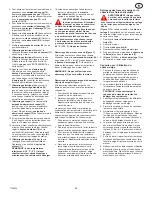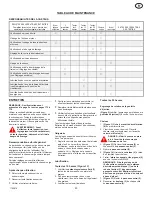
en
11
1740876
15. (Electric Start) First disconnect the power
cord from the three−hole receptacle. Then,
disconnect the power cord from the switch
box (11).
NOTE: In temperatures below 0
5
F (−18
5
C),
allow the engine to warm up for several
minutes before blowing snow.
16. When throwing snow, always run the engine
with the throttle control (13), if equipped, in
the fast position.
WARNING: Never run the engine
indoors or in enclosed, poorly
ventilated areas. Engine exhaust
contains carbon monoxide, an odorless
and deadly gas. Keep hands, feet, hair and
loose clothing away from any moving parts
located on the engine or the snow thrower.
The temperature of muffler and nearby
areas may exceed 150
°
F (66
5
C). Avoid
these areas.
How To Start A Warm Engine (Figure 1)
If an engine has been running and is still warm,
leave the choke control (14) in the off position
and do not push the primer button (9). If the
engine fails to start, follow the instructions “How
To Start A Cold Engine”.
NOTE: Do not use the primer button (9) to
start a warm engine.
How To Start An Engine With A Frozen Electric
Starter (Figure 1)
If the electric starter is frozen and will not turn
the engine, follow the instructions below.
1. Pull as much starter rope as possible out of
the starter.
2. Release the starter handle and let it snap
back against the starter. Repeat until the
engine starts.
Warm engines will cause condensation in cold
weather. To prevent possible freeze−up of recoil
starter and engine controls, proceed as follows
after each snow removal job.
1. Run the snow thrower a few minutes after
throwing snow to prevent freeze−up of the
auger/impeller.
2. With engine off, allow engine to cool for
several minutes.
3. Pull starter rope very slowly until resistance
is felt, then stop. Allow the starter rope to
recoil. Repeat three times.
4. With the engine not running, wipe all snow
and moisture from the carburetor cover in
area of controls and levers. Also, move the
choke control and starter handle several
times.
How To Remove Snow or Debris From
The Auger Housing
WARNING: Do not attempt to
remove snow or debris that may
become lodged in auger housing
with your hands. Use the clean−out tool or
a pry bar to remove snow or debris.
(Figure 7) On some models, a clean−out tool
(1) is attached to the top of the auger housing.
Use the clean−out tool (1) to remove snow
from the auger housing.
1. Release the auger drive lever (5).
2. Stop the engine.
3. Remove the safety key (8).
4. Disconnect the spark plug wire.
5. Do not place your hands in the auger
housing (4) or the discharge chute (3).
6. (Figure 7) Use the clean-out tool (1) or a
pry bar to remove any snow or debris.
Snow Throwing Tips
1. For maximum snow thrower efficiency in
removing snow, adjust ground speed. Go
slower in deep, freezing or wet snow. If the
wheels slips, reduce forward speed.
2. Most efficient snow throwing is accomplished
when the snow is removed immediately after
if falls.
CAUTION: Do not overload the machine
capacity by attempting to clear snow at
too fast a rate.
3. For complete snow removal, slightly overlap
each previous path.
4. Whenever possible, discharge the snow
down wind.
5. For normal usage, set the skids so that the
scraper bar is 1/8” (3 mm) above the skids.
For extremely hard−packed snow surfaces,
adjust the skids upward so that the scraper
bar touches the ground.
6. Rocks and gravel must not be picked up and
thrown by the machine. On gravel or crushed
rock surfaces, set the skids at 1−1/4 inch
(32 mm) below the scraper bar. See “How To
Adjust The Height Of The Skids” in the
Maintenance section.
7. After each snow throwing job, allow the
engine to idle for a few minutes. The snow
and accumulated ice will melt off the engine.
8. Clean the snow thrower after each use.
9. Remove ice, snow and debris from the entire
snow thrower. Flush with water to remove all
salt or other chemicals. Wipe snow thrower
dry.
MAINTENANCE CHART
CUSTOMER RESPONSIBILITIES
SERVICE RECORDS
Fill in dates as you complete regular
service.
Before
Each
Use
First 2
Hours
Every
5
Hours
Every
10
Hours
Every
25
Hours
Each
Season
Before
Storage
SERVICE DATES
Check Engine Oil Level
√
√
√
Change Engine Oil
√
√
Check And Tighten All Screws and Nuts
√
√
Check Spark Plug
√
√
Adjust Drive Belt
√
√
√
Check Fuel
√
Drain Fuel
√
Check Auger Clutch Cable Adjustment (See
Cable Adjustment)
√
√
Check Traction Clutch Cable Adjustment
(See Cable Adjustment)
√
√
Lubricate All Pivot Points
√
√
Lubricate Auger Shaft (See Shear Bolt
Replacement)
√
√
Lubricate Drive Chains and Sprockets
√
√
Summary of Contents for 6291570X61
Page 2: ...2 1740876 3 18 16 17 15 7 19 4 8 9 10 11 12 13 14 2 1 5 20 1 6 ...
Page 5: ...en 5 1740876 3 2 22 3 2 22 22 22 4 3 ...
Page 6: ...en 6 1740876 2 2 22 0 2 5 8 6 7 2 A 8 A 6 8 8 8 2 A 2 ...
Page 46: ...it 46 1740876 6 9 9 9 9 9 9 2 2 2 6 9 2 9 2 S 2 9 9 6 2 9 9 2 6 6 9 6 2 9 S 9 GG R ...
Page 171: ...171 1740876 Notes ...
Page 172: ...172 1740876 2 1 1 1 2 2 2 ...
Page 173: ...173 1740876 1 2 3 4 2 1 5 4 6 7 3 9 10 1 11 18 15 12 16 5 1 1 2 3 4 5 6 6 7 1 ...
Page 174: ...174 1740876 2 1 8 2 6 7 8 9 10 9 5 6 7 10 1 2 11 12 4 2 1 3 11 5 10 ...
Page 176: ...176 1740876 21 19 24 23 22 20 4 5 5 6 8 3 2 1 21 22 2 3 4 A 23 ...
Page 177: ...177 1740876 24 2 3 4 4 5 6 8 4 25 3 4 5 6 26 11 3 1 2 10 27 28 18 ...
Page 178: ...178 1740876 29 30 31 34 35 30 32 33 19 20 11 8 7 16 16 19 20 8 7 14 13 13 7 31 32 17 17 ...


























